Become A Sponsor
|
Why Ads

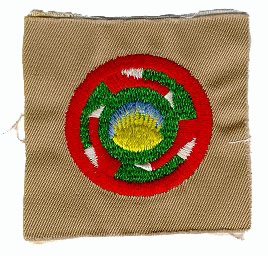
Ku-Ni-Eh Square Patch
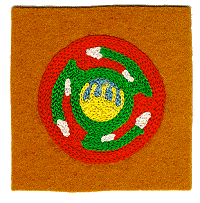
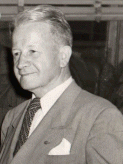 The Tribe of Ku-Ni-Eh
The Tribe of Ku-ni-eh was a very widespread honor camper society that was
in existence from the Great Lakes area to the Gulf of Mexico to the Atlantic
coastal states. It was created in 1922 in the Cincinnati Area Council in
Ohio by Arthur E. Roberts, their Scout Executive and camp director. He had
been looking for a program to keep older boys interested in scouting and
found it within the Kankau, a tribe of the Maidu Indians of Northern
California. The Tribe of Ku-ni-eh was based at Camp Edgar Friedlander in
Ohio. The symbol of the society was the "We-Hin-Ah-Pay" (means rising sun)
which was a design taken from the base of the Maidu Indian ceremonial basket
of the same name. Ku-Ni-Eh means "Order of Manhood". It was a Maidu Indian
ceremony that was a rite of passage from boy to man and tested the youth in
virtues neccesary to become a brave. A Ku-ni-eh handbook from 1923 is known
to exist and a ceremonial manual was published and copyrighted by Arthur
Roberts in 1926. The Tribe of Ku-Ni-Eh
The Tribe of Ku-ni-eh was a very widespread honor camper society that was
in existence from the Great Lakes area to the Gulf of Mexico to the Atlantic
coastal states. It was created in 1922 in the Cincinnati Area Council in
Ohio by Arthur E. Roberts, their Scout Executive and camp director. He had
been looking for a program to keep older boys interested in scouting and
found it within the Kankau, a tribe of the Maidu Indians of Northern
California. The Tribe of Ku-ni-eh was based at Camp Edgar Friedlander in
Ohio. The symbol of the society was the "We-Hin-Ah-Pay" (means rising sun)
which was a design taken from the base of the Maidu Indian ceremonial basket
of the same name. Ku-Ni-Eh means "Order of Manhood". It was a Maidu Indian
ceremony that was a rite of passage from boy to man and tested the youth in
virtues neccesary to become a brave. A Ku-ni-eh handbook from 1923 is known
to exist and a ceremonial manual was published and copyrighted by Arthur
Roberts in 1926.
Where The Tribe of Ku-ni-eh existed
The tribe reportedly existed at the following councils (and probably others)
and in the following states:
- Blue Grass Council (KY)
- Blue Ridge Council (SC)
- Caddo Area Council (TX.)
- Cape Fear Area Council (NC) *
- Cincinnati Area Council(OH)
- Commanche Trail Council (TX)
- Concho Valley Council (TX)
- Firelands Council (OH)
- Four Rivers Council (KY)
- Heart O' Texas Council
- Indian Trails Council (WI)
- Lonesome Pine Council (KY)
- Louisville Area Council (KY)
- Milwaukee County Council (WI)
- Northern Kentucky Council (KY)
- Palmetto Council (SC)
- Pee Dee Council (SC)
- Potawatomi Area Council (WI)
- Southwest Texas Council (TX)
- Tuscarora Council (NC)
- Upper Cumberland Council (KY),
* Bob Walton wrote to us and noted "The tribe of Ku-Ni-Eh was used as a camp
honor society at Camp Kilodeska, Cape Fear Area Council, Wilmington, NC in 1936,
37& 38. It was also used, by the council, at Camp Singletary in 1939.
I have not found any reference to Ku-Ni-Eh after 1939." An outline of the Tribe of Ku-ni-eh that was written in the 1940's states
that the Tribe was active in Ohio, Kentucky, Tennessee, Virginia, West
Virginia, North Carolina, South Carolina, southern Indiana and Illinois.
Which specific councils within those states was not mentioned. The list
didn't mention the states of Wisconsin and Texas which had numerous councils
using the Ku-ni-eh program.
Selection into the Tribe
- Conditions of Membership into Ku-Ni-Eh:
- Loyalty to the Ideals of Scouting.
- Orderliness and neatness of person, tent and camp.
- Advancement in the program of Scoutcraft.
- General out of doors knowledge; Helpfulness towards new boys.
- Participation in construction and sanitation.
- Participation in the programs.
- Cheerfulness in service and discipline.
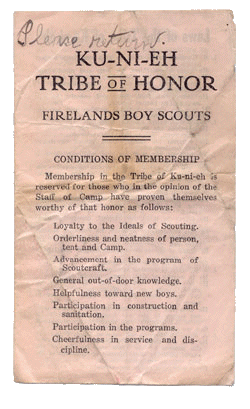
Unlike the OA which has members of a scout's troop choose who will be
selected to join, candidates for Ku-ni-eh were selected by Tribe members.
The 1923 handbook details the procedure as follows: "At the end of each
camping session at which the tribe is represented, all of the available
members assemble at a time which is appointed by Mishenewa. With the sponsor
present, recommendation for tribal membership is made by any member for any
camper. Each candidate is discussed by each tribal member. When a candidate
has been considered by everyone, he is then voted upon in an open ballot and
those who receive a unanimous vote are accepted for the Tribe."
The Laws and Song Of the Tribe of Ku-ni-eh
The Nine Laws of Ku-Ni-Eh.
- A Ku-Ni-Eh brave tries to gain and keep perfect health.
- A Ku-Ni-Eh brave controls himself.
- A Ku-Ni-Eh has courage.
- A Ku-Ni-Eh is reliable and trustworthy.
- A Ku-Ni-Eh observes the rules of Clean Play.
- A Ku-Ni-Eh is dutiful.
- A Ku-Ni-Eh is a good workman.
- A Ku-Ni-Eh is kind.
- A Ku-Ni-Eh is Loyal
The Song of Ku-Ni-Eh
(Tune: Maryland, My Maryland)
Where e'er on earth we chance to be,
Ku-Ni-Eh, my Ku-Ni-Eh,
Our hearts will ever turn to thee,
Ku-Ni-Eh, my Ku-Ni-Eh,
Thy spirit makes us ever strong,
Thy comradeship we praise in song,
Miami's waters carry it on, *
Ku-Ni-Eh, my Ku-Ni-Eh.
Thy faith and trust we safely keep,
Ku-Ni-Eh, my Ku-Ni-Eh,
In waking hours and midnight sleep,
Ku-Ni-Eh, my Ku-Ni-Eh,
Our fondest thoughts are for our tribe,
And tho' we're scattered far and wide,
In spirit we'll be side by side,
Ku-Ni-Eh, my Ku-Ni-Eh.
*The name Miami was substituted with the name of a local body of water
nearest the particular Tribe. In the Firelands Council it was Lake Erie.
Miami was used by the original Tribe in Cincinnati.
The Ordeal and Initiation Ceremony of Ku-ni-eh
An account of the ordeal and ceremony in the Comanche Trail Council in Texas
stated that candidates had an arrow scratched into their arm with a needle
and they were given an arrow shaft and told to make a completed arrow with
their name on it. It was placed in a quiver with the other member's arrows.
If they disgraced the scouting ideals their arrow was shot into the air. If
they could not find it they were out of the society. In Comanche Trail,
candidates were awakened at midnight and were roped together and hiked until
dawn blindfolded. They then made their breakfast then took a bath in a tank
of cold water. Later they worked throughout the day to complete their
ordeal. It was not unusual to wake up in the morning and find your tentmate
missing and he would be gone for three days. He would return as a member of
the Tribe of Ku-Ni-Eh. It was introduced in Comanche Trail after a local
scout became a member of the society at the scout camp in Waco, Texas (Heart
O' Texas Council) and brought it back with him. Entry into Ku-Ni-Eh was a
three day process and the ceremonial script was eight typed pages.
Some of the main Indian characters in the Ku-Ni-Eh ceremonial were Mishenewa
(the friend brave) (spelled Mishenowa in the handbook), Go-wa-na (the father
brave), Tah-ko-dah (the Tribe Chief), Fire-builder and Ka-wi-da (the wise
brave). The handbook also names "Wenidi", (the story teller brave). Based on
information in the ceremonial book there was an overnight time where
candidates were kept together in a general area. Each was given a small
leaflet with the laws and song of Ku-Ni-Eh printed on it. They were sent off
to seek solitude and to study the information on the leaflet before meeting
the chief the next day. If they met another candidate in the forest they
were they were to remain silent, give the sign of frienship and pass on.
There were two passwords that they had to learn; the first was "Service" and
the second was "Prepared". Members were given the Ku-ni-eh badge as well as
a Ku-ni-eh handbook which had on the back cover the statement: "The holding
of this handbook asserts that___________ is a member of the Tribe of
Ku-ni-eh."
The Membership Badge of Ku-ni-eh
Ku-Ni-Eh did have a national membership badge (patch). "Badges in wholesale
lots of 39 dozen may be secured from Lion Brothers of Baltimore. Small
quantities may be secured from Cincinnati Scout Headquarters at cost and
mail. The badges are silk embroidered, similar to merit badges and same
size..." (quoted from the 1926 ceremonial book). The size of the square
cloth was about the same as merit badges back then but the embroidered
circle was silver dollar size. Sometimes the square was cut down to round as
was done with the square merit badges.
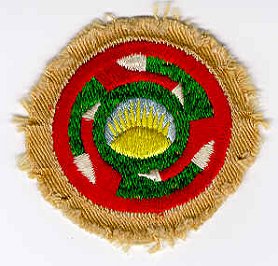 1930s
1930s
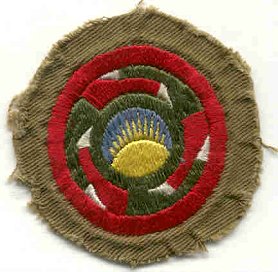 1940s
1940s
The early patch was chain stitch
embroidered on felt and the later version was embroidered on twill
material. Apparently when the program reached the Comanche Trail Council in
Texas in 1935, the fact that there was a national patch was unknown to them.
They created their own local Ku-ni-eh patch which was a square leather
fringed patch with Indian markings on it. In the Otena Lodge 295 history it
states that there was no national Ku-ni-eh patch even though there was. An
explaination of the national badge design was given in the 1923 handbook
which states: "We take the sun for our symbol and guide because it meant to
the Indian honor and fidelity, it gives light and warmth, it chases away the
shadows and the gloom. It follows a straight course through the skies and
is never swayed from it's purpose. Be like the sun. Find out that which is
good and hold fast to it. Remember the story of the hound and the stag; lack
of imagination led him from a real goal to a lesser and lesser one until he
got off track completely. The sun teaches us to pick our objective and
follow a straight course toward the goal. About the sun is the blue sky of
the morning when all things begin anew. Green like nature in springtime
means blossoming manhood. White is for purity. Red is for health, virility,
and the heart from which issues life. Whenever you look upon this symbol,
renew your vows to Ku-ni-eh. To be a true member of this Tribe and loyal to
it's teachings will insure fair weather to you throughout life."
The Tribe of Ku-ni-eh Monument in Kentucky
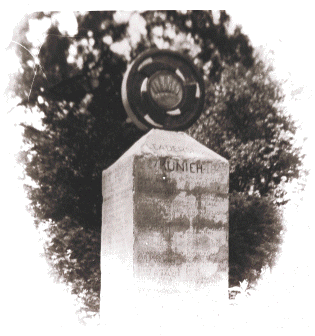 A Ku-ni-eh monument was erected at Camp Offutt in Versailles, Kentucky which
was the camp of the Blue Grass Council. The camp existed from 1923 to 1960.
The monument listed all of the members of the local Tribe of Ku-ni-eh from
1927-1943. I am told that the monument still exists to this day. The totem
(the Ku-ni-eh patch on top) was poured and painted concrete. The totem was
removed from its engraved limestone base in 1960 when the camp closed and it
was remounted on top of another stone structure at the OA ceremony grounds
at McKee Scout Reservation in Mount Sterling, KY. Over the years the Kunieh
symbol deteriorated, and eventually was removed. It's pieces have survived
and they have been put back together in a frame, something like a large jig
saw puzzle weighing between 50-100 pounds. The tapered limestone base
portion of the monument (with the names of all of the Ku-Ni-Eh members of
that time) is still at old Camp Offutt. The new owners of the camp felt that
it should stay a part of the place and it has for all of these years. The
first name that was inscribed on the monument was O.C. Rankin who was the
"sponsor" of the Blue Grass Council Tribe of Ku-ni-eh. He was inducted into
the society at Camp Friedlander in Cincinnati and is believed to be the
person who brought Ku-ni-eh to Kentucky and promoted it. He agressively
resisted the OA replacing Ku-ni-eh and never joined the Kawida OA lodge. He
died in 1969. I was told by a member of Kawida lodge that even after the OA
lodge was started in 1952 the Ku-ni-eh continued to induct members and give
out the membership patch. This went on into the 1960's.
A Ku-ni-eh monument was erected at Camp Offutt in Versailles, Kentucky which
was the camp of the Blue Grass Council. The camp existed from 1923 to 1960.
The monument listed all of the members of the local Tribe of Ku-ni-eh from
1927-1943. I am told that the monument still exists to this day. The totem
(the Ku-ni-eh patch on top) was poured and painted concrete. The totem was
removed from its engraved limestone base in 1960 when the camp closed and it
was remounted on top of another stone structure at the OA ceremony grounds
at McKee Scout Reservation in Mount Sterling, KY. Over the years the Kunieh
symbol deteriorated, and eventually was removed. It's pieces have survived
and they have been put back together in a frame, something like a large jig
saw puzzle weighing between 50-100 pounds. The tapered limestone base
portion of the monument (with the names of all of the Ku-Ni-Eh members of
that time) is still at old Camp Offutt. The new owners of the camp felt that
it should stay a part of the place and it has for all of these years. The
first name that was inscribed on the monument was O.C. Rankin who was the
"sponsor" of the Blue Grass Council Tribe of Ku-ni-eh. He was inducted into
the society at Camp Friedlander in Cincinnati and is believed to be the
person who brought Ku-ni-eh to Kentucky and promoted it. He agressively
resisted the OA replacing Ku-ni-eh and never joined the Kawida OA lodge. He
died in 1969. I was told by a member of Kawida lodge that even after the OA
lodge was started in 1952 the Ku-ni-eh continued to induct members and give
out the membership patch. This went on into the 1960's.
In Conclusion
There are still many councils who have lost track of what honor
society/programs they had before the OA (if any). I suspect there are a few
out there that had Ku-Ni-Eh that have yet to rediscover it. The society no
longer exists but there still is a Ku-Ni-Eh OA Lodge 145 in Ohio and their
flaps still include the We-Hin-Ah-Pay (Rising Sun) within their design.
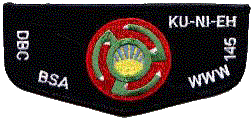
Kawida OA Lodge 480 in Kentucky took their lodge name directly from one of
the Indian braves in the Ku-ni-eh ceremonial.
Information and scans provided
by Tim Brown, Jack Simon, Joe Foxhuber, Paul Myers, and Bill Topkis.
Material found on this page is the work of David L. Eby and used USSSP, Inc. by permission. This material may not be reproduced without the express permission of David L. Eby
|





